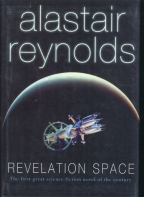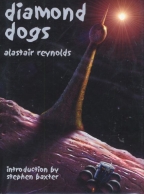 |
|
'Revelation Space' offers an infusion of grotty horror into a wonderfully conceived scinec fictional universe. |
|
|
|
(Science) Fiction by Alastair Reynolds
The Agony Column for July 30, 2002
Commentary by Rick Kleffel
I sat out on science fiction for a good chunk of time. But when I really started reading it again, a couple of years ago, a good experience put me right back in the game. I'd gone through Peter F. Hamilton's 'Night's Dawn' novels and enjoyed them immensely. Of course, immense is surely the watchword with these three huge novels, any one of which has enough pages to comprise a cheesy fantasy trilogy. I was on the lookout for more British science fiction, and the best place to do so according to my tiny mind at that time was -- and I know this goes against my better independent bookstore leanings, but the truth is the truth -- amazon.co.uk. The SF department there is pretty great. Helmed by the wonderful, erudite and entertaining David Langford, their choices tended to jive my own peculiar tastes. So when Langford recommended a mid-sized (at least in this SUV-oriented world) novel by an author I'd never heard of -- 'Revelation Space' by Alastair Reynolds. I took a chance on Langford's recommendation, and it was the start of a wonderful and still continuing reading experience.
 |
|
'Revelation Space' offers an infusion of grotty horror into a wonderfully conceived scinec fictional universe. |
Although it's only 476 pages long, 'Revelation Space' is a big book. The folks at Victor Gollancz printed it in an unusually wide format, one that made it very easy to read. I haven't seen any books printed in this particular size other than those by Reynolds. Since reading requires many things to work -- the reader's eyes, the lights, the chair one is seated in -- anything that helps, well, helps. To this reader, big-format books help. 'Revelation Space' lay nice and flat when I put it on the table to read. Score one point for VG/Reynolds. On the other hand, I must admit that I wasn't impressed with the cover art. While in the end I've got to admit that it's not all that important, in these days of beautiful Jim Burns' covers, it seemed a bit small and sparse.
Of course what matters is what's inside, and from the first page it was clear that Reynolds was offering something different from the science fiction I'd read in the past. This is no gleaming future. This is no Star Trek. There's no FTL travel, no hyperdrive and the story is staggered in time and space. It was dirtier, grittier, and much, much darker. Buried in the darkness was a flinty gleam of bleak humor. And over the whole shebang was a coating of slime, dust and dirt that I hadn't encountered much outside the realm of well-written horror. In fact, this novel has a lot to commend it as a horror novel.
|
|
|
This issue of Interzone features one of Reynolds' enjoyable horrific science fiction stories, with excellent cover art for the story itself. |
A look at one of Reynolds' short stories, featured in 'Interzone' yields more clues as to the authors' horrific leanings. 'Hideaway' begins with the telling, chilling line: "There was, Merlin thought, a very fine line between beauty and terror." Reynolds likes to live in this space -- in space. His universe is fraught with terrorizing beauty, intricate, delicate constructs wrought from deliquescing slime and the rusted parts of machines whose purpose is no longer discernable. When Reynolds puts these together, he builds one hell of a ghost-ridden mansion.
'Revelation Space' has the best haunted house since Shirley Jackson and Richard Matheson gave us their ghosts. It's the ship Nostalgia for Infinity, which is described in beautifully detailed prose. The closest analogue to this ship that I can remember is the castle Gormenghast. Both are larger than the inhabitants know, both hold secrets and dangers, both are dark with age and dank with disuse. As in Gormenghast, there's a bit of humor built into Reynolds' dark vision, an appreciation of the absurdity that follows humans and their creations. How many readers remember John Carpenter's talking bombs in 'Dark Star'? Apparently, Reynolds does, because they get a new life in Reynolds house of horrors. They're equally horrifying and funny. And like any good house of horrors, this ship is haunted -- by the Captain.
The Captain is one of the aspects of 'Revelation Space' that really endeared the book to this reader. Again, remember that I was before this novel primarily a horror fan, though I had plenty of background in reading SF. Yes, the old ship-as-captain / captain-as-ship has been done before, but never with such slimy sensibility. Reynolds came up with a wonderful future and a wonderful fall, The Melding Plague. It plays a huge part in his second novel, 'Chasm City'.
|
|
|
Alastair Reynolds' second novel is a noir set in the same universe as his first novel, 'Revelation Space'. It features a city transfigured by a horrific plague. |
'Chasm City' is a sideways sequel. It's set in the same universe as 'Revelation Space', but doesn't answer many of the questions raised by that novel. It begins with a wonderful straight-out-of-a-horror-novel warning. You are entering Chasm City, once mighty and proud, now laid to waste by the Melding Plague. For a moment, put in your mind an Arabian-influenced cross between the cities you saw in those atrocious 'Star Wars' prequels. Now imagine the wonderfully detailed Aurora model kits that you could have bought of them had they been made 30 years ago, when the movies wouldn't have seemed so terrible. Assemble those kits in your mind, dig a trench in your backyard and install them in the trench. Take your time painting them; make sure every detail is right. Wait for a sunny day. Then break out the magnifying glass and start melting. You're starting to get the idea of 'Chasm City' and the Melding Plague.
'Chasm City' preserves and even extends the slimy ambience of 'Revelation Space', but plays a noir mystery plot across this wide, detailed background. As with many noir plots, there's more than a grain of both horror and humor in the depths of 'Chasm City'. And like many noirs, there's a question of identity at core. A literary feel pervades the novel as the strands unwind and the onion is peeled, layer by layer. It's also another big-format, easy-to-lay-down book. Though Reynolds writes compelling, page turning prose, I try to hold back and make the books last.
|
|
 |
|
This coffee-stained copy of H. P. Lovecraft's famous Arkham house collection 'Dagon' contains the story 'In the Walls of Eyrx', one of the few pure science fiction stories he ever penned. |
'Diamond Dogs', Reynolds' novella for Peter Crowther's PS Publishing offers an excellent update on Lovecraft's classic theme. |
Still, there was a bit of frustration with an author who asked some many interesting questions and gave only half the answers, an author who left so may wonderfully woven threads dangling. The next book didn't answer any of those questions, but it wasn't meant to and didn't try. Instead, for 111 pages, PS Publishing's 'Diamond Dogs' focuses on characters who are all too human and then melts them like an ice cream cone in a baby's fist on a hot summer day. Once again, we're in the universe of 'Revelation Space' and 'Chasm City'. But Reynolds simply, clearly sets up his characters and runs them through an alien maze that is designed to kill -- or deconstruct -- those who enter it. Reynolds boils his characters down to bare bones and then bends the bones. It's a chilling classic science fiction horror story, which follows in the footsteps of H. P. Lovecraft's entry into science fiction, 'In the Walls of Eryx'. Lovecraft would be proud.
Reynolds latest novel, 'Redemption Ark', ups the ante of both horror and over-the-top humor. It's also offers some of his finest character work, wherein he creates a character whom I was seeing and describing to myself in a very particular fashion. Only afterwards did I read in an interview that the writer had conceived of the character in the precise terms that I came to describe him with. Reynolds is clearly a writer who knows how to create the exact effect that wants to evoke with his prose.
Literary characters will only get you so far. That can be really, really far. But when Reynolds starts taking the characters of 'Redemption Ark' to the next level, he literally goes for the throat. Yes, the novel is filled with wonderful, thought-provoking science fictional inventions. But just beyond the gritty exterior beats the heart of a humor-filled horror writer, someone who can describe the icky bloodbath, bathe, laugh and make the reader enjoy the sensation of the drying scabs falling off as one flexes one's limbs. Reynolds knows how to freeze the reader with a delicious, imaginative terror and then dare them to chuckle. Moreover, he never ever descends into the merely jokey, into the stupid side of flip. His fully-realized characters are merely allowed to exist in a world that includes humor. This is often a failing of science fiction that's hard to notice. But when someone does it right, when the characters are truly, fully rounded, it can really add depth to the narrative.
If there's any problem with Reynolds writing it's that he's in the middle of a Great Work. We're lucky that he's a good enough writer to be able to pause in his narrative. He's writing about billions of years, trillions of lives, the minds of men we can come to know and understand. As long as we get our annual novel, we'll have to feel well-served. These are the kinds of books that one thinks 'This would make a fantastic movie' for say, about a minute. Then you realize that no movie could match the immersive experience that good writing can offer. There's no need for a movie. Open the book. You've just read the trailer.
Thanks,
Rick Kleffel